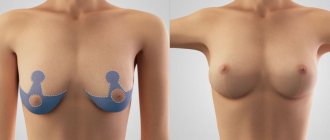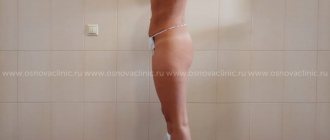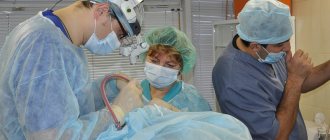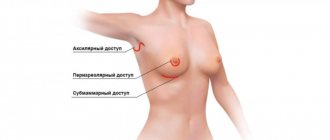Mammoplasty is one of the most spectacular plastic surgeries. The changes in the before and after photos will not leave anyone indifferent. Surgeons at the GALAXY Beauty Institute are ready to help every woman create the breasts of her dreams. Well, patients, accordingly, are required to follow all the rules of rehabilitation after surgery for as long as required. Then the final result will be truly stunning.
- Why is it important to follow all recommendations in the postoperative period?
- First week of rehabilitation
- Compression garments after mammoplasty
- Limitations after mammoplasty
Why is it important to follow all recommendations in the postoperative period?
The correct selection of techniques and implants, careful preparation for surgery and skillfully performed intervention will provide only part of the success. The appearance of the breast after full recovery largely depends on how the rehabilitation after mammoplasty goes. Compliance with all doctor’s recommendations will ensure:
- minimal risk of complications;
- beautiful shape and symmetry of the mammary glands;
- correct position of the implant;
- invisible scars even when located around the areola;
- minimum pain and other unpleasant sensations.
IMPORTANT! The recovery time for the body depends on the type of mammoplasty. If a lift or reduction surgery has been performed, the tissue will return to normal faster. Breast augmentation using implants requires more recovery time as the body must get used to the foreign body.
Care of the operated area
At first, the mammary glands will be swollen and painful. This is absolutely normal and there is no need to worry. Hematomas may also be observed. A doctor's examination will only be needed if these phenomena last a very long time or the sensations are too pronounced.
The surgeon will definitely give advice and recommendations on proper recovery after mammoplasty. This includes, for example, daily treatment of sutures with antiseptic preparations. It is also possible to use ointments that accelerate tissue regeneration. It is prohibited to choose your own treatment; the use of any means must first be discussed with the surgeon.
The doctor may also prescribe a special therapeutic massage. The technique is demonstrated in advance. As is the case with other nuances of breast care, giving yourself a massage without the appointment of a specialist is highly not recommended.
First week of rehabilitation
The patient wakes up in a comfortable room at the GALAXY Beauty Institute. The first day you must remain in the hospital under the supervision of medical personnel. Strict bed rest with minimal physical activity is required.
If recovery proceeds at a normal pace, discharge occurs the next day after surgery. The decision on this is made by the surgeon after a thorough examination. The patient is taught the rules for caring for sutures, prescribed painkillers, antibiotics, antiseptics for treating the wound, and other drugs can be added if necessary.
The first days at home should also be spent in peace. At this time, a woman may be bothered by a slight increase in temperature, swelling of the tissues and pain in the chest area. Doctors at the GALAXY Beauty Institute will give detailed instructions on what and how to take in this situation.
Bruising and swelling are normal tissue reactions to surgery. As they recover, their severity will decrease.
IMPORTANT! It is necessary to come to the clinic for an appointment to check the condition of the stitches and dressings as often as the attending physician advises.
If suture removal is required, it is carried out 7-10 days after the intervention. 2 weeks after the operation, you can go to work if it does not involve significant physical activity.
Compression garments after mammoplasty
Wearing special compression garments is one of the most important conditions for successful rehabilitation after breast augmentation. It is put on immediately after surgery and worn for 1 month. This allows:
- reduce the risk of seams coming apart;
- form thin, invisible scars;
- ensure a neat breast shape after completion of rehabilitation;
- accelerate the resorption of swelling and bruises;
- evenly distribute the load on the neck and spine.
Surgeons at the GALAXY Beauty Institute independently select underwear for the patient. It is included in the cost of the operation and meets the following criteria:
- provides comfort in any position;
- allows the skin to breathe;
- absorbs moisture;
- looks neat under clothes;
- easily fastened by the patient herself.
In the first 4-5 weeks, a compression bra is worn constantly. After about a month, you can replace the compression garment with a regular bra without wires, which provides good support for the mammary glands. The exact timing depends on the specific operation and the individual characteristics of the body.
How is mastopexy performed?
Correction of prolapse is performed using one of the following methods:
- lipareolar,
- vertical,
- T-shaped.
The periareolar incision is located along the entire edge of the areola and is carried out in a circular motion. Vertical adds a slit from the bottom edge to the crease under the bust. Finally, the T-shaped or anchor, in addition to the previous ones, also contains a horizontal cut in the fold itself. The technique is chosen by the surgeon based on the patient’s individual situation. Depending on the degree of prolapse (ptosis), the number of incisions and the volume of excised tissue increases.
The periareolar approach is indicated for mild ptosis, and the anchor approach is recommended for patients with naturally large breasts and a severe degree of ptosis.
Limitations after mammoplasty
Restrictions after mammoplasty last from 1-2 weeks to several months. Compliance with these rules allows tissues to recover properly. Here is a list of the most important prohibitions.
- You cannot raise your arms above shoulder level. This rule should be followed for about a week after surgery. An unsuccessful movement can dislodge the implant.
- Do not strain your pectoral muscles: lift weights, drive a car. In addition to pain, the violation can cause sutures to separate and the implant to dislodge. The driving restriction lasts no more than 2 weeks; you need to be careful with heavy weights for up to a month.
- You should not shower for 7 days after surgery, as unhealed wounds may become infected.
- You cannot take a bath or swim in a pool or open water until the surgeon’s permission (2-3 months minimum).
- You should not sleep on your stomach or side for 2-3 weeks. The reason is the risk of suture divergence and implant displacement.
- You can't have sex for 10 days. Hormonal fluctuations during intimacy cause a rush of blood to the mammary glands. This increases swelling and the risk of bleeding.
- You can't play sports. This issue is resolved individually with a doctor. The duration of the restrictions depends on the type of sports activity. Ignoring this limitation often provokes complications: hematomas, seromas, bleeding, suture dehiscence.
- You can't overheat. It is advisable to wait at least 6 months. A hot bath, sauna, steam bath can affect scar formation.
- You cannot sunbathe in the sun or in a solarium for up to 1 year. Ultraviolet light can cause darkening of the seams.
- It is undesirable to smoke and drink alcohol 1-2 weeks before and 1 month after surgery. Bad habits slow down blood circulation and tissue healing.
- You can’t suddenly lose weight or gain weight. Weight fluctuations must be very slow, otherwise the tissues may stretch and the appearance of the operated breast will become unpresentable.
On average, complete recovery of the body after surgery takes from 6 months to 1 year.
The rehabilitation period after mammoplasty is very important. If a woman follows all the doctor’s requirements, then very soon the swelling and bruising will go away, the scars will become invisible, and the breasts will delight with an ideal appearance.
Breast augmentation with implants
Implant installation methods
Taking into account the individual anatomy and other factors listed above, the plastic surgeon chooses one of three methods (types of surgical access) for breast augmentation:
- Areolar (breast enlargement “through the areola”).
- Submammary.
- Axillary.
Below we discuss in detail the features, pros and cons of each method of augmentation mammoplasty.
Areolar access
With the areolar, or periareolar, approach, the plastic surgeon installs the implants through an incision that runs along the periphery of the pigmented area of the areola. The main advantage of this surgical approach is the invisibility of scars. The scar is located on the border between light and dark skin, and therefore it is quite difficult to notice.
The periareolar method of breast augmentation has other advantages, in addition to the minimal severity of the postoperative scar:
- During the operation, it is possible to perform plastic surgery of the nipple-areolar complex. In some cases, achieving optimal bust aesthetics without correcting the size and shape of the SAH is difficult, and this advantage of the periareolar approach can play a decisive role.
- The periareolar approach eliminates the risk of damage to the afferent (sensory) nerve fibers that pass to the SAC in the area of the inframammary fold. Thanks to this advantage, the areolar method of mammoplasty allows you to completely preserve the sensitivity of the nipple and areola.
- Simultaneously with bust enlargement, the initial stage of mastoptosis can be corrected.
Despite the advantages of the periareolar approach listed above, the technique cannot be recommended for all women. In particular, this method of installing implants is not recommended for girls who plan to have children and breastfeed them. This is explained by the fact that during the operation there is a risk of damage to the milk ducts, which will affect lactation function. The periareolar approach does not allow a complete view of all implant pockets, which imposes restrictions on the size of the implant. This method is well suited for those patients who want to have a small implant and slightly enlarge their breasts. In a situation where a woman wants to add 2-3 sizes to her mammary glands, it is preferable to use submammary or axillary access.
Submammary access
With submammary access, the installation of endoprostheses is carried out through horizontal incisions that pass under the mammary gland in a natural skin fold. Postoperative scars when using this method of installing implants are significantly pronounced, but they are hidden in a fold of skin. The scars are visible in a lying position, and in a standing position they are covered by the lower pole of the mammary gland. The main advantage of the submammary approach is a very good overview of the surgical field. For a plastic surgeon, this is the easiest type of mammoplasty, since there is full access to all implant pockets and it is easy to achieve absolutely symmetrical placement of the implants. Thanks to this feature, large endoprostheses can be installed.
Another advantage of the submammary bust enlargement technique is that there is no risk of damage to the milk ducts. After the operation, the lactation function is preserved, which makes it possible to recommend this method to patients who plan to become pregnant and breastfeed a baby in the future.
The submammary method of installing implants is not without its drawbacks. For many patients of plastic surgeons, the main disadvantage of the technique is a pronounced and fairly extended scar, which runs in the fold under the breast. A disadvantage is the risk of damage to the afferent nerves innervating the SAC. If the nerve is cut during surgery, the sensitivity of the nipple and areola will be impaired. The use of submammary access does not allow performing SAH repair through one incision simultaneously with augmentation mammoplasty. In addition, women who have initial signs of breast ptosis (mastoptosis) often seek the help of a plastic surgeon. If the periareolar approach eliminates age-related manifestations, then when using submammary access it is impossible to correct mastoptosis simultaneously with breast augmentation.
Axillary access
With the axillary approach, breast augmentation is performed through incisions located in the armpit. The key advantage of the technique is that the scars extend away from the mammary glands and do not affect their aesthetic perception. On the other hand, scars are noticeable and this can become a problem if a woman wears revealing clothes. For example, scars can be clearly visible during sports, especially in a body position with arms raised up. However, it is the axillary approach that is considered the “gold standard” in augmentation mammoplasty. The operation is performed under the control of fiber optic equipment (endoscope), which allows the plastic surgeon to gain access to all implant pockets. There is no risk of damage to the nerve trunks. There is also no risk of cutting the milk ducts, which makes it possible to recommend this method of installing implants to girls planning a pregnancy. There are no restrictions in terms of the size of the endoprosthesis - the axillary type of access allows you to place implants of any volume, shape and profile.
The disadvantages of the axillary method of breast augmentation are that the plastic surgeon does not have the opportunity to correct the consequences of ptosis of the mammary glands or perform plastic surgery of the nipple-areolar complex. For this reason, the axillary approach is used mainly to simulate bust size when there are no associated aesthetic problems requiring surgical correction.
Criteria for choosing a surgical approach
In clinical practice, plastic surgeons use several criteria for choosing a surgical approach for breast augmentation. One of the main criteria is the woman’s age and her future plans regarding pregnancy. If the patient plans to give birth to children, it is advisable to refuse the periareolar approach. Axillary or submammary access is preferable.
If a woman does not plan to give birth, any of the previously discussed types of surgical access can be used. In situations where it is necessary to perform areola plastic surgery to improve the aesthetics of the bust simultaneously with its enlargement, the periareolar approach is preferable. This same method of installing implants is better suited for patients with initial signs of mastoptosis.
For patients who want to enlarge their bust by several sizes, a plastic surgeon may recommend the submammary or axillary method.
The optimal choice in this situation is considered to be breast augmentation through the axillary fossa, but the woman’s aesthetic wishes are also taken into account. If she expresses a desire to hide the scar in a natural fold under the breast, a submammary approach is chosen. Make an appointment











